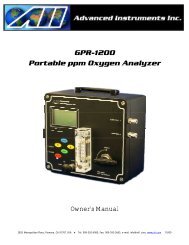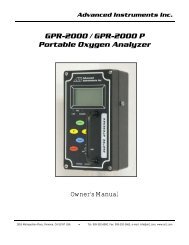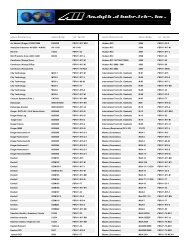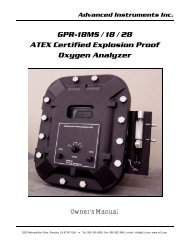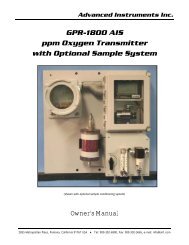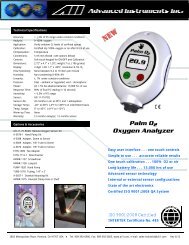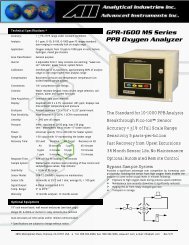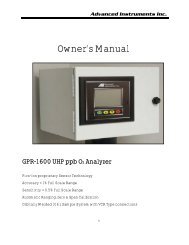GPR-2600 Series Oxygen Analyzer - Advanced Instruments Inc.
GPR-2600 Series Oxygen Analyzer - Advanced Instruments Inc.
GPR-2600 Series Oxygen Analyzer - Advanced Instruments Inc.
Create successful ePaper yourself
Turn your PDF publications into a flip-book with our unique Google optimized e-Paper software.
<strong>Advanced</strong> <strong>Instruments</strong> <strong>Inc</strong>.InstallationGas Sample Stream: Ensure the gas stream composition of the application is consistent with the specifications and review theapplication conditions before initiating the installation. Consult the factory to ensure the sample is suitable for analysis.Contaminant Gases: A gas scrubber and flow indicator with integral metering valve are required upstream of the of theanalyzer to remove interfering gases such as oxides of sulfur and nitrogen or hydrogen sulfide that can produce false readings,reduce the expected life of the sensor and void the sensor warranty if not identified at time of order placement. Installation of asuitable scrubber is required to remove the contaminant from the sample gas to prevent erroneous analysis readings anddamage to the sensor or optional components. Consult the factory for recommendations concerning the proper selection andinstallation of components.Expected Sensor Life: With reference to the publish specification located as the last page of this manual, the expected life ofall oxygen sensors is predicated on oxygen concentration (< 1000 ppm or air), temperature (77°F/25°C) and pressure (1atmosphere) in “normal” applications. As a rule of thumb sensor life is inversely proportional to changes in the parameters.Deviations are outside the specifications and will affect the life of the sensor. Avoid exposure to oxygen levels near 100% for anextended period of time.Accuracy & Calibration: Refer to section 5 Operation. The 0-25% range is provided not only as a measuring range but forthe purpose of air calibration which is the recommended method of calibration. Optionally, the analyzer can be calibrated with acertified span gas or compressed instrument air at the user’s discretion. Note: The oxygen sensor’s inherent linearity andabsolute zero properties facilitates single point calibration.Materials: Assemble the necessary zero, purge and span gases and optional components such as valves, coalescing orparticulate filters, and, pumps as dictated by the application; stainless steel tubing is essential for maintaining the integrity ofthe gas stream for ppm and percentage range (above or below ambient air) analysis; hardware for mounting.Operating Temperature: The sample must be sufficiently cooled before it enters the analyzer and any optional components.A coiled 10 foot length of ¼” stainless steel tubing is sufficient for cooling sample gases as high as 1,800ºF to ambient. Themaximum operating temperature is 45º C on an intermittent basis unless the user is willing to accept a reduction in expectedsensor life – refer to analyzer specification - where expected sensor life is specified at an oxygen concentration less than 1000ppm oxygen for ppm analyzers and air (20.9% oxygen) for percent analyzers, but in all instances at 25°C and 1 atmosphere ofpressure. Expected sensor varies inversely with changes in these parameters.Pressure & FlowAll electrochemical oxygen sensors respond to partial pressure changes in oxygen. The sensors are equally capable of analyzingthe oxygen content of a flowing sample gas stream or monitoring the oxygen concentration in ambient air (such as a confinedspace such in a control room or an open area such as a landfill or bio-pond).<strong>Analyzer</strong>s designed for in-situ ambient or area monitoring have no real inlet and vent pressure because the sensor is exposeddirectly to the sample gas and intended to operate at atmospheric pressure, however, slightly positive pressure has minimaleffect on accuracy.Sample systems and flowing gas samples are generally required for applications involving oxygen measurements at oxygenconcentrations and pressures other than ambient air. In these situations, the use of stainless steel tubing and fittings is criticalto maintaining the integrity of the gas stream to be sampled and the inlet pressure must always be higher than the pressure atthe outlet vent which is normally at atmospheric pressure.The sensor is exposed to sample gas that must flow or be drawn through metal tubing inside the analyzer. The internal samplesystem includes 1/8” compression inlet and vent fittings, a corrosion resistant or stainless steel sensor housing with an o-ringseal to prevent the leakage of air and stainless steel tubing.Inlet Pressure: <strong>Analyzer</strong>s designed for flowing samples under positive pressure or pump vacuum (for samples at atmosphericor slightly negative atmospheres) that does not exceed 14” water column are equipped with bulkhead tube fitting connectionson the side of the unit (unless otherwise indicated, either fitting can serve as inlet or vent) and are intended to operate atpositive pressure regulated to between 5-30 psig although the rating of the fitting itself is considerably higher. Caution: If theanalyzer is equipped with an optional H2S scrubber, inlet pressure must not exceed 30 psig.6



